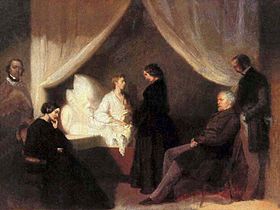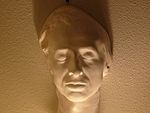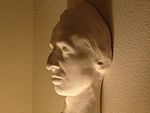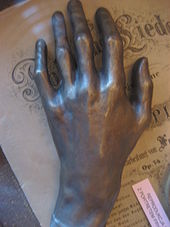- Chopin's disease
-
 Chopin on His Deathbed, by Kwiatkowski, 1849, commissioned by Jane Stirling. Chopin sits in bed, in presence of (from left) Aleksander Jełowicki, Chopin's sister Ludwika, Marcelina Czartoryska, Wojciech Grzymała, Kwiatkowski.
Chopin on His Deathbed, by Kwiatkowski, 1849, commissioned by Jane Stirling. Chopin sits in bed, in presence of (from left) Aleksander Jełowicki, Chopin's sister Ludwika, Marcelina Czartoryska, Wojciech Grzymała, Kwiatkowski.
Frédéric Chopin's disease, and the reason for his premature death at age 39, remain unclear. Though he was diagnosed in his lifetime with tuberculosis and treated for it, since his death in 1849 a number of alternative diagnoses have been suggested.
Contents
Case history
Chopin's death mask, created by Auguste Clésinger 17 October 1849 (photographs from the collection of Jack Gibbons)Frédéric Chopin was, from childhood, sickly and under medical care. He showed intolerance of fatty foods, especially pork – these caused stomachaches, diarrhea and weight loss. Later he endeavored to avoid such symptoms with diet; he obtained substantial improvement with ingredients such as honey and oat bran. Chopin attained a height of 170 centimetres (5 ft 7 in) — the 25th percentile; and at age 28 he weighed 45 kilograms (99 lb) — below the 3rd percentile.
Chopin is known at 22 to have had no facial hair: as he wrote in the winter of 1832, he grew sideburns on only one side of his face.[1] In 1826 he was sick for six months, suffering from enlarged cervical lymph nodes and severe headaches. In 1830 a chronic cold caused nasal swelling which prompted him to cancel planned concerts in Vienna.
In 1831, in Paris, 21-year-old Chopin experienced his first hemoptysis (coughing up of blood). In 1835 he suffered a severe two-month laryngitis and bronchitis, and the resulting interruption in his correspondence with Warsaw gave rise to gossip that he had died.[2]
In early youth he treated himself with belladonna. In the final decade of his life, he treated the coughing fits from which he had suffered all his life, with a blend of sugar and opium. Chopin coughed up abundant mucus, especially about ten in the morning.[3] He occasionally drank alcohol, sometimes smoked and – as some authors noted – suffered the consequences of inhaling others' smoke while enjoying the company of his Parisian friends.[1] In the last year of his life, he endured diarrheas, caused either by cor pulmonale or by exocrine pancreatic insufficiency (see below).
On 17 October 1849, at 2 a.m., after a sudden coughing fit, Chopin died in the 40th year of his life. His physician, Jean Cruveilhier, confirmed his death by holding a mirror to Chopin's mouth and by illuminating his pupils with light from a candle. Pursuant to Chopin's will, Dr. Cruveilhier, a renowned professor of pathology, carried out an autopsy. The postmortem report was destroyed either in the Paris fire of 1871 or during World War Two. The death certificate stated the cause of Chopin's death as tuberculosis of the lungs and larynx. However, Wojciech Grzymała, in a letter to Auguste Leo dated October 1849, wrote that the autopsy had not confirmed tubercular pulmonary changes and that his actual disease was unknown to contemporary medicine. The postmortem findings were also communicated to Chopin's sister Ludwika, Adolf Guttmann and Jane Stirling, and their later letters were consistent as to the findings.[4]
Physicians
It is uncertain how many physicians Chopin had; various authors have given the number as 14,[5] 31[6] or "nearly 50".[7] In addition, the composer had friendly relations with other physicians, who may also have occasionally provided him with assistance.[6]
In Warsaw, Chopin's physicians were Jan Fryderyk Wilhelm Malcz, Franciszek Girardot and Fryderyk Adolf Roemer. In Vienna, Chopin was provided medical care by Johann Malfatti. Chopin's physicians in Paris included Aleksander Hofman, Jean-Jacques Molin, André François Cauviere, Jan Matuszyński, Adam Raciborski, Pierre Gaubert, Gustave Papet and Coste. During his 1848 stay in London – Mallan and James Clark. In Paris, in 1848–49, he was treated by Léon Simon, Fraenkel, David Koreff, Louis and Roth.[1] Chopin's last physician was Jean Cruveilhier.
Family history
Little is known about the health of Frédéric’s father. Mikołaj Chopin lived to age 74 and suffered several times from respiratory infections. The composer's mother had no chronic illness and reached the age of 87.
Of Frédéric’s three sisters, Izabela died at age 70 and had no illnesses; Ludwika suffered from recurrent respiratory infections and died at 47; the youngest, Emilia, was of frail health from earliest childhood. Emilia suffered from recurrent coughs and dyspnea; at 11 she began having hemorrhages from the upper gastrointestinal tract, and she died of a massive hemorrhage at 14.
Hypotheses
Tuberculosis
Chopin was diagnosed with tuberculosis and treated for it in accordance with contemporary practice, including bloodletting and purging. Tuberculosis figured in his death certificate, despite the alleged absence of typical organ changes. Critics of alternative hypotheses about Chopin's disease point out the abundant evidence for tuberculosis.[8][9][10] Chronic coughs and hemoptysis are common symptoms of tuberculosis; complications may include both pericarditis, causing right-heart insufficiency, and bronchiectasis, manifesting in productive cough and respiratory failure.
A 20-year history of hemoptysis is rare in tuberculosis, but not impossible. Similarly, cavernous tuberculosis is rare in childhood, but cannot be excluded in the case of Emilia Chopin. Frédéric could have contracted tuberculosis from his younger sister.[11] Against the diagnosis of tuberculosis stands the fact that some physicians who cared for Chopin did not diagnose him with that common, well-known disease. Another argument against tuberculosis would be the absence, in Cruveilhier’s report, of organ changes typical of tuberculosis, and gastrointestinal symptoms that cannot be explained by tuberculosis.[12]
A monograph on historic methods of treating tuberculosis has discussed individual treatments on the example of Chopin, since his history well illustrates mid-19th-century views on treating tuberculosis.[13]
Cystic fibrosis
The hypothesis that Chopin suffered from cystic fibrosis was first presented by O’Shea in 1987.[14] It has been supported and popularized by physicians from the Medical University of Poznań.[15] Arguments for cystic fibrosis as the chief cause of Chopin’s complaints are: the onset of the condition in early childhood, possible familial occurrence (Emilia), gastrointestinal symptoms, intolerance of fat-rich meals, recurrent infections of the lower respiratory tract, also suppurative, with exacerbations in winter, recurrent infections of the upper respiratory tract (laryngitis, sinusitis), barrel chest (visible in some photographs and caricatures), low tolerance of physical exercise, an episode of heatstroke (more frequent in cystic fibrosis), caries (more pronounced in this disease), putative infertility.[16]
There is no evidence for clubbed fingers – a symptom of hypertrophic osteoarthropathy, frequent in cystic fibrosis – but hand and ankle arthralgia in his last year of life may relate to this condition.[17] It has been suggested that Chopin suffered from a mild form of cystic fibrosis, its course worsened by coexisting tuberculosis or another mycobacteriosis.[18] Confirmation for the cystic fibrosis hypothesis might be obtained by genetic testing of preserved body tissues, but so far scientists have not been granted permission to take samples from Chopin's heart, which is immured in a pillar inside Warsaw's Holy Cross Church.[19] A full review of the possible causes of Chopin's illness has recently been published.[20]
Alfa 1-antitrypsin deficiency
A hypothesis of alpha 1-antitrypsin deficiency was proposed by Kuzemko in 1994.[1] According to this hypothesis, Emilia's fatal hemorrhage was caused by ruptured esophageal varices, secondary to liver cirrhosis in the course of alfa 1-antitrypsin deficiency. Frédéric's symptoms of liver insufficiency would be hypoproteinemia, feminization features (no facial hair) and gastrointestinal bleeding. His death would be explained by liver failure and respiratory failure due to chronic obstructive pulmonary disease.
Supporters of the cystic-fibrosis hypothesis argue, against Kuzemko, that cystic fibrosis would explain Chopin’s symptoms equally well.[15][21] Kuzemko himself has conceded that typical symptoms of liver cirrhosis in the course of alfa 1-antitripisin deficiency would be jaundice and ascites.
Kuzemko’s hypothesis has been cited by Reuben[22] and Eriksson[23] in 2003.
Mitral stenosis
Mitral stenosis is a possible, if unlikely, cause for the artist’s complaints and was discussed by Kubba and Young in 1998.[24] The most important argument against this hypothesis is the absence of evidence that Chopin suffered from rheumatic fever in childhood, which is the most common cause of mitral valve stenosis.
Other diseases
Kubba and Young have pointed out a number of other conceivable, if unlikely, diagnoses, besides cystic fibrosis and alfa 1-antitripsin deficiency: Churg-Strauss syndrome, allergic bronchopulmonary aspergillosis, hypogammaglobulinemia, idiopathic pulmonary haemosiderosis, lung abscesses, and pulmonary arteriovenous malformations.[24]
Infertility
Chopin possibly was sexually active from early adulthood, but left no descendants. Some authors consider this evidence for infertility, which would tend to strengthen the cystic-fibrosis hypothesis.[15]
Depression, etc.
Chopin's biographers have often touched on the subject of depression, but the topic has rarely been broached by psychiatrists. One of the few studies of Chopin’s mental condition is a 1920 work by Bronislaw Onuf-Onufrowicz. The author cited biographers concerning Chopin's character and psyche and pointed out some symptoms that might indicate a manic-depressive disorder (aka bipolar disorder) or dementia praecox (now termed schizophrenia), but he emphasized the absence of evidence for severe psychosis and the fact that single symptoms may only suggest a predisposition to such mental illnesses.[25]
See also
References
- ^ a b c d Kuzemko, JA (1994). "Chopin's illnesses". Journal of the Royal Society of Medicine 87 (12): 769–72. PMC 1294992. PMID 7853308. http://www.pubmedcentral.nih.gov/articlerender.fcgi?tool=pmcentrez&artid=1294992.
- ^ John O'Shea: Music & Medicine: Medical Profiles of Great Composers. London: Dent, 1990, p. 144. ISBN 0-460-86106-9
- ^ John O'Shea: Music & Medicine: Medical Profiles of Great Composers. London: Dent, 1990, p. 143. ISBN 0-460-86106-9
- ^ John O'Shea: Music & Medicine: Medical Profiles of Great Composers. London: Dent, 1990, p. 149. ISBN 0-460-86106-9
- ^ K. Barry, "Chopin and His Fourteen Doctors", Sydney Austral. Med. Publish. Co., 1934, cited from Sielużycki, 1976.[page needed]
- ^ a b Sielużycki C (1976). "Lekarze Chopina". Archiwum Historii Medycyny 39 (3): 305–32.
- ^ E. Stocki (1956), "Zapomniani lekarze-przyjaciele Fryderyka Chopina", Polski Tygodnik Lekarski, 24, pp. 1102-4 (1956). Cited from Sielużycki, 1976.
- ^ Cheng, TO (1998). "Chopin's illness". Chest 114 (2): 654–5. doi:10.1378/chest.114.2.654-a. PMID 9726766.
- ^ Margolis, ML (1998). "The long suffering of Frederic Chopin, revisited". Chest 114 (2): 655. doi:10.1378/chest.114.2.655. PMID 9726767.
- ^ Carter, ER (1998). "Chopin's malady". Chest 114 (2): 655–6. doi:10.1378/chest.114.2.655-a. PMID 9726768.
- ^ O'Shea, John M. (1990). Music & medicine: medical profiles of great composers. London: Dent. pp. 142–3. ISBN 0-460-86106-9.
- ^ Cheng, T. O. (1998). "Chopin's Illness". Chest 114 (2): 654–5. doi:10.1378/chest.114.2.654-a. PMID 9726766.
- ^ Long, Esmond R. (1956). A History of the Therapy of Tuberculosis and the Case of Frederic Chopin. Lawrence, Kansas: University Press of Kansas. OCLC 14617261.[page needed]
- ^ O'Shea, JG (1987). "Was Frédéric Chopin's illness actually cystic fibrosis?". The Medical journal of Australia 147 (11-12): 586–9. PMID 3320707.
- ^ a b c Majka, L; Goździk, J; Witt, M (2003). "Cystic fibrosis--a probable cause of Frédéric Chopin's suffering and death". Journal of applied genetics 44 (1): 77–84. PMID 12590184.
- ^ John O'Shea: Music & Medicine: Medical Profiles of Great Composers. London: Dent, 1990, p. 152. ISBN 0-460-86106-9
- ^ John O'Shea: Music & Medicine: Medical Profiles of Great Composers. London: Dent, 1990, p. 141. ISBN 0-460-86106-9
- ^ Persson, H; Wikman, B; Strandvik, B (2005). "Frederic Chopin--the man, his music and his illness.". Przeglad lekarski 62 (6): 321–5. PMID 16225061.
- ^ http://przekroj.pl/cywilizacja_nauka_artykul,6198,0.html
- ^ Lagerberg, Steven. "Chopin's Heart - The Quest to Identify the Mysterious Illness of the World's Most Beloved Composer." Lagerberg, 2011, ISBN:145640296X.
- ^ Phelan, PD (1995). "Chopin's illnesses". Journal of the Royal Society of Medicine 88 (8): 483–4. PMC 1295316. PMID 7562840. http://www.pubmedcentral.nih.gov/articlerender.fcgi?tool=pmcentrez&artid=1295316.
- ^ Reuben, A (2003). "Chopin's serpin". Hepatology (Baltimore, Md.) 37 (2): 485–8. doi:10.1002/hep.510370244. PMID 12540812.
- ^ Eriksson, S (2003). "Did Chopin suffer of antitrypsin deficiency? Lost autopsy protocol has caused frustration among physicians of our time in their attempts to confirm the diagnosis". Lakartidningen 100 (30-31): 2449–54. PMID 12914142.
- ^ a b Kubba, AK; Young, M (1998). "The long suffering of Frederic Chopin". Chest 113 (1): 210–6. doi:10.1378/chest.113.1.210. PMID 9440592.
- ^ Onuf-Onufrowicz, Bronislaw (1920). "Frederick Chopin’s Mental Makeup". Dementia Praecox Studies 3 (1–2): 199–204. http://books.google.com/books?id=O4tXAAAAMAAJ&pg=PA199.
Categories:- Frédéric Chopin
- Health by individual
- Retrospective diagnosis
Wikimedia Foundation. 2010.



